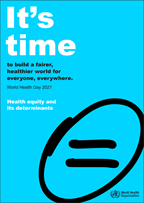
Food Systems for Health
A food system includes all the elements (environment, people, inputs, processes, infrastructures, institutions, etc.) and activities that relate to the production, processing, distribution, preparation and consumption of food, and the outputs of these activities, such as socio-economic and environmental outcomes.
At the root of many of the world’s most pressing threats to human, animal and planetary health, are unhealthy, inequitable and unsustainable food systems. Around 11 million deaths annually are caused by unhealthy diets. Our diets have become the leading contributor to global environmental degradation, affecting land, water and oceans, biodiversity, our climate and our air quality.
Food systems may also affect health by facilitating the spread of common bacteria and germs from animals to humans and between human populations. The use of antibiotics in livestock breeding and aquaculture contributes to drug-resistant microbes that threaten human health
We need to transform food systems to:
- lower the cost of nutritious foods for consumers,
- increase the availability and affordability of healthy diets,
- ensure a fair price for the producer, while reflecting the true costs on environment, health and livelihoods
Achieving this could: help prevent the double burden of malnutrition (the co-existence of undernutrition along with overweight and obesity, or diet-related noncommunicable diseases e.g. diabetes, within individuals, households and populations); lower health costs related to unhealthy diets; lower food waste and the social costs of greenhouse gas emissions; and advance progress on all 17 UN Sustainable Development Goals in this Decade of Action on Nutrition (2016-2025). WHO is working to advance food systems transformation for health through the priority policy actions detailed below, as well as through the outcomes of the UN Food Systems Summit including the Coalition of Action for Healthy Diets from Sustainable Food Systems for Children and All (HDSFS).
Seven Action Areas

Taxes on foods and beverages that are high in fats, salt and/or sugars is used to encourage healthy options. Subsidies on healthy alternatives make them more affordable to consumers.

Food purchased with public funds or served or sold in public settings: school meals, government canteens, food support programmes, hospital or prison meals.

Regulating food and non-alcoholic beverages ads, or targeted campaigns, that negatively influence or limit choices among children or mothers

Vegetables are washed and prepared lunch at a rural home in northern Vietnam.

The reduction of salt, sugar or unhealthy fats in processed foods and beverages

Increasing the nutrient value of foods by fortifying them with vitamins and minerals, like adding iodine to salt, or iron to wheat or maize flours.

Publications
All →This policy brief provides policy-makers, programme managers, health professionals and advocates with information and policy options related to the implementation...
Food reformulation is the process of altering the processing or composition of a food or beverage product, to improve its nutritional profile or to reduce...
Nutrition labelling: policy brief
This policy brief provides policymakers, programme managers, health professionals and advocates with information and options for nutrition labelling policies,...
This policy brief provides policy-makers and programme managers, health professionals and advocates with information and policy options to increase protection...
Documents

Health equity and its determinants
This is the second World Health Day to fall during the COVID-19 pandemic – the world’s worst peacetime health crisis in a century. It comes...















